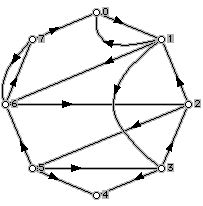
Digraphs and Relations
prepared by:
Joseph Malkevitch
Department of Mathematics and Computing
York College (CUNY)
Jamaica, New York 11451
email: joeyc@cunyvm.cuny.edu
web page: www.york.cuny.edu/~malk
There are many examples of people that are related and things that are related. We speak of John being Mary's father, and Jack being Joan's friend. We speak of one chair being larger than another chair and a pair of triangles being similar. We can capture a lot of these everyday issues with the mathematical concept of a relation. Given a set of objects A, a relation on a is a subset of the ordered pairs of elements from A. An element can be related to itself. Given two elements x and y in A, x can be related to y, y can be related to x, both x related to y and y related to x can occur, or there may be no relation between x and y. We can draw a diagram with directed line segments joining dots called a digraph to represent a relation or we can use such a directed graph to define a relation.
An example of a digraph D is shown below:

Exercises:
1. How many vertices does D have?
2. How many directed edges does D have?
3. Write down the indegree (invalence) of each vertex of D.
4. Write down the outdegree (outvalence) of each vertex of D.
5. Verify that the sum of the invalences of the vertices of D equals the number of edges of D.
6. Verify that the sum of the outvalences of the vertices of D equals the number of edges of D.
7. Write down as many (simple) cycles as you can that include the vertex 0.
8. Can you find a path that begins at vertex 1 and ends at vertex 0?
9. Can you find a path that begins at vertex 0 and ends at vertex 1?
10. A vertex x is reachable from vertex y if there is a path from y to x.
a. Find all the vertices reachable from vertex 4.
b. Find all the vertices reachable from vertex 6.
c. Find all the vertices reach able from vertex 2.
11. Does this digraph have a vertex from which all other vertices are reachable?
12. Give some examples of real world situations where it might be desirable to have a digraph for which there was at least one vertex from which all the other vertices were reachable.
13. If a digraph has 7 vertices what is the largest number of edges it can have if it has no two edges which join a pair of vertices in the same direction nor any loops. If a graph has 7 vertices and no multiple edges or loops what is the largest number of edges it can have?
14. Write down the pairs in the relation defined by the digraph above.